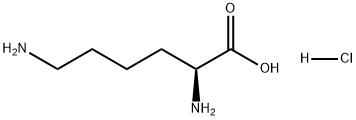Synthesis
L-Lysine hydrochloride can be synthesisied by microbial fermentation to give crude L-Lysine , and then purified and synthesized by crystallization in hydrochloric acid.
Description
L-Lysine hydrochloride is a white or nearly white, practically odorless, free-flowing, crys talline powder. It is freely soluble in water, but is almost insoluble in alcohol and in ether. It melts at about 260°C with decomposition.
Chemical Properties
White crystalline powder
Uses
L-Lysine hydrochloride is widely used as nutritional supplements in food and beverage industries. It can also be used in animal feed as source of L-Lysine. It can be used in a wide variety of industries including: food production, beverage, pharmaceutical, agriculture/animal feed, and various other industries.
Definition
ChEBI: The hydrochloride salt of L-lysine
Biochem/physiol Actions
L-lysine is an essential amino acid in animals and humans. L-Lysine is necessary for protein synthesis in the body and proper growth. L-lysine lowers the cholesterol level by producing carnitine. L-lysine aids in calcium, zinc and iron absorption. Athletes take L-lysine as a supplement for lean mass building and for proper muscle and bone health. L-lysine competes with arginine during viral replication and reduces herpes simplex virus infection. L-lysine supplementation reduces chronic anxiety in human. Lysine reduces viscosity of serum albumin solution for injections.
Side effects
L-Lysine hydrochloride may cause side effects such as stomach pain and diarrhea.
Safety Profile
L-Lysine hydrochloride is hazardous by inhalation. When heated to decomposition it emits very toxic fumes of HCl and NOx.
Purification Methods
Likely impurities are arginine, D-lysine, 2,6-diaminoheptanedioic acid and glutamic acid. Crystallise the monohydrochloride from water at pH 4-6 by adding 4 volumes of EtOH. At above 60% relative humidity it forms a dihydrate. [Birhbaum et al. J Biol Chem 194 455, 468 1952, Kearley & Ingersoll J Am Chem Soc 73 5783 1951, Beilstein 4 IV 2717.]




